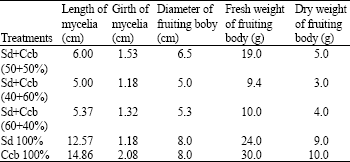Research Article
The Growth and Yield Performance of Oyster Mushroom (Pleurotus ostreatus) on Different Substrates
Deaprtment of Crop Science, School of Agriculture, University of Cape Coast, Ghana
G.C. Van der Puije
Deaprtment of Crop Science, School of Agriculture, University of Cape Coast, Ghana
E.A. Bediako
Deaprtment of Crop Science, School of Agriculture, University of Cape Coast, Ghana
E.A. Abole
Deaprtment of Crop Science, School of Agriculture, University of Cape Coast, Ghana
F. Showemimo
Faculty of Agriculture, Amedu Bello University, Zaria, Nigeria












cynthia haw starty Reply
i need info for literature review
John Nelson Buah
I have a few documents for you so if i can have your email, i will send them to you.
Divya D Reply
Hi, I'm doing a project on growing oyster mushrooms and was wondering if you had any information about whether the density of the spawn on the substrate affected fruiting of the mushrooms.
Thank you
Divya
John Nelson Buah
In our case, the density of the spawn did not affect the fruiting.
ASHA SINGH RAJAVAT Reply
hi im doing a cultivation of oyster mushroom on paddy straw and i need some information related in this way